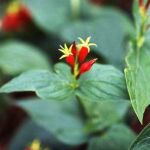| Common Name: |
Indian Pink |
| Other Names: |
Rainbow pink, Chinese pink |
| Botanical Name: |
Dianthus chinensis |
| Genus: |
Dianthus |
| Family: |
Caryophyllaceae |
| Native Location: |
S Europe, N Africa |
| Cultivation: |
Well-drained, neutral to alkaline soil in sun. May be affected by a number of diseases, especially when grown under cover, including Botrytis, Fusarium, and Verticillium wilts, powdery mildew, and leaf and stem rots. |
| Propagation: |
By seed swon in spring or autumn at 13°C (55°F); by cuttings of non-flowering shoots in summer. Dianthus chinensis is usually grown as an annual. |
| Harvest: |
Flowers of D. caryophyllus are picked after 3 hours exposure to morning sunshine and used fresh for oil extraction and culinary use, or dried for potpourris. Plants of D. chinensis are cut just before the flower buds open and dried for use in decoctions, pills, powders, and poultices. |
| Varieties: |
Strawberry parfait
Is compact, with white, pink-flushed, red-centered flowers, 5cm (2in) across.
Height: 20cm (8in)
Width: 20cm (8in) |
| Height: |
30-45cm (12-18in) |
| Width: |
15-23cm (6-9in) |
| Hardiness: |
Z4-7 |
| Parts Used: |
Whole plant (qu mai) |
| Properties: |
A bitter, tonic, diuretic herb that stimulates the digestive and urinary systems, and bowels. It also lowers blood pressure, relieves fevers, and controls bacterial infections. |
| Medicinal Uses: |
Internally for acute urinary tract infections (especially cystitis), urinary stones, constipation, and failure to menstruate. Combined with Salvia miltiorhiza (See, red sage) to induce menstruation. Externally, for skin inflammations, swellings, and eczema. |
| Bibliography: |
Encylopedia of Herbs by Deni Brown Copyright ©: 1995, 2001 Dorling Kindersley Limited pg 192-193
|
